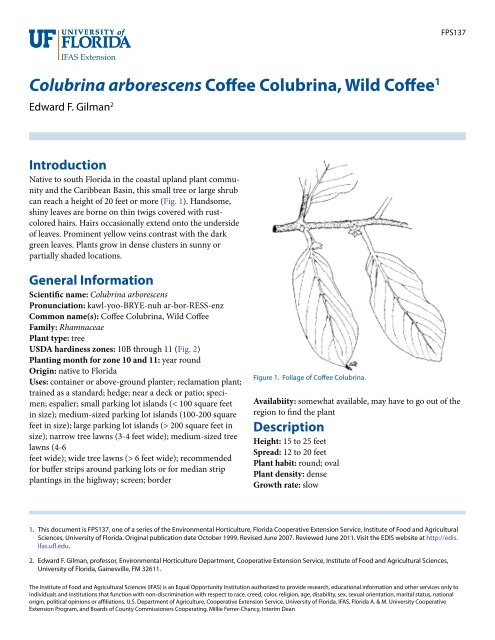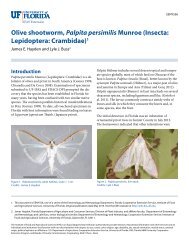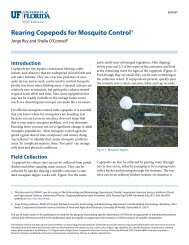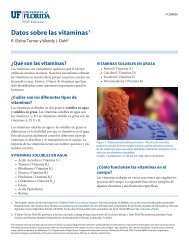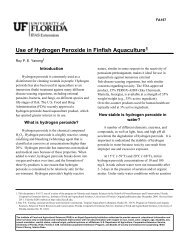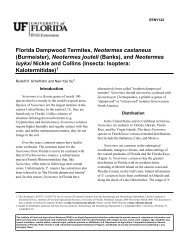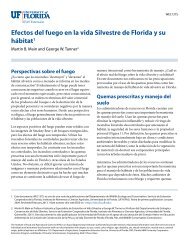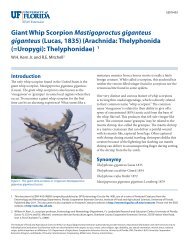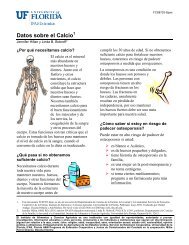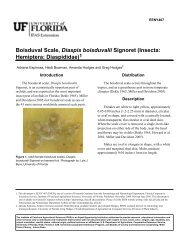Colubrina arborescens Coffee Colubrina, Wild Coffee1 - EDIS ...
Colubrina arborescens Coffee Colubrina, Wild Coffee1 - EDIS ...
Colubrina arborescens Coffee Colubrina, Wild Coffee1 - EDIS ...
Create successful ePaper yourself
Turn your PDF publications into a flip-book with our unique Google optimized e-Paper software.
<strong>Colubrina</strong> <strong>arborescens</strong> <strong>Coffee</strong> <strong>Colubrina</strong>, <strong>Wild</strong> <strong>Coffee</strong> 1<br />
Edward F. Gilman 2<br />
Introduction<br />
Native to south Florida in the coastal upland plant community<br />
and the Caribbean Basin, this small tree or large shrub<br />
can reach a height of 20 feet or more (Fig. 1). Handsome,<br />
shiny leaves are borne on thin twigs covered with rustcolored<br />
hairs. Hairs occasionally extend onto the underside<br />
of leaves. Prominent yellow veins contrast with the dark<br />
green leaves. Plants grow in dense clusters in sunny or<br />
partially shaded locations.<br />
General Information<br />
Scientific name: <strong>Colubrina</strong> <strong>arborescens</strong><br />
Pronunciation: kawl-yoo-BRYE-nuh ar-bor-RESS-enz<br />
Common name(s): <strong>Coffee</strong> <strong>Colubrina</strong>, <strong>Wild</strong> <strong>Coffee</strong><br />
Family: Rhamnaceae<br />
Plant type: tree<br />
USDA hardiness zones: 10B through 11 (Fig. 2)<br />
Planting month for zone 10 and 11: year round<br />
Origin: native to Florida<br />
Uses: container or above-ground planter; reclamation plant;<br />
trained as a standard; hedge; near a deck or patio; specimen;<br />
espalier; small parking lot islands (< 100 square feet<br />
in size); medium-sized parking lot islands (100-200 square<br />
feet in size); large parking lot islands (> 200 square feet in<br />
size); narrow tree lawns (3-4 feet wide); medium-sized tree<br />
lawns (4-6<br />
feet wide); wide tree lawns (> 6 feet wide); recommended<br />
for buffer strips around parking lots or for median strip<br />
plantings in the highway; screen; border<br />
Figure 1. Foliage of <strong>Coffee</strong> <strong>Colubrina</strong>.<br />
1. This document is FPS137, one of a series of the Environmental Horticulture, Florida Cooperative Extension Service, Institute of Food and Agricultural<br />
Sciences, University of Florida. Original publication date October 1999. Revised June 2007. Reviewed June 2011. Visit the <strong>EDIS</strong> website at http://edis.<br />
ifas.ufl.edu.<br />
2. Edward F. Gilman, professor, Environmental Horticulture Department, Cooperative Extension Service, Institute of Food and Agricultural Sciences,<br />
University of Florida, Gainesville, FM 32611.<br />
The Institute of Food and Agricultural Sciences (IFAS) is an Equal Opportunity Institution authorized to provide research, educational information and other services only to<br />
individuals and institutions that function with non-discrimination with respect to race, creed, color, religion, age, disability, sex, sexual orientation, marital status, national<br />
origin, political opinions or affiliations. U.S. Department of Agriculture, Cooperative Extension Service, University of Florida, IFAS, Florida A. & M. University Cooperative<br />
Extension Program, and Boards of County Commissioners Cooperating. Millie Ferrer-Chancy, Interim Dean<br />
FPS137<br />
Availabiity: somewhat available, may have to go out of the<br />
region to find the plant<br />
Description<br />
Height: 15 to 25 feet<br />
Spread: 12 to 20 feet<br />
Plant habit: round; oval<br />
Plant density: dense<br />
Growth rate: slow
Figure 2. Shaded area represents potential planting range.<br />
Texture: medium<br />
Foliage<br />
Leaf arrangement: alternate<br />
Leaf type: simple<br />
Leaf margin: entire<br />
Leaf shape: ovate<br />
Leaf venation: pinnate<br />
Leaf type and persistence: evergreen<br />
Leaf blade length: 2 to 4 inches<br />
Leaf color: green<br />
Fall color: no fall color change<br />
Fall characteristic: not showy<br />
Flower<br />
Flower color: yellow<br />
Flower characteristic: year-round flowering<br />
Fruit<br />
Fruit shape: round<br />
Fruit length: less than .5 inch<br />
Fruit cover: fleshy<br />
Fruit color: black<br />
Fruit characteristic: attracts birds<br />
Trunk and Branches<br />
Trunk/bark/branches: not particularly showy; typically<br />
multi-trunked or clumping stems<br />
Current year stem/twig color: brown<br />
Current year stem/twig thickness: medium<br />
Culture<br />
Light requirement: plant grows in part shade/part sun<br />
Soil tolerances: occasionally wet; acidic; slightly alkaline;<br />
sand; loam; clay<br />
Drought tolerance: high<br />
Soil salt tolerances: good<br />
Plant spacing: 36 to 60 inches<br />
Other<br />
Roots: usually not a problem<br />
Winter interest: no special winter interest<br />
Outstanding plant: plant has outstanding ornamental<br />
features and could be planted more<br />
Invasive potential: not known to be invasive<br />
Pest resistance: long-term health usually not affected by<br />
pests<br />
Use and Management<br />
<strong>Colubrina</strong> makes a good hedge or screen planting due to<br />
the dense canopy. Plant on 5 feet centers to establish a solid<br />
mass of foliage several years after planting. Single plants can<br />
be trained into a small tree by periodically removing lower<br />
foliage and branches as the tree grows taller. It will make a<br />
nice ornamental next to the patio or deck since the foliage<br />
is pretty and the fruit is small. Small fruit also make this<br />
plant suitable for planting near a swimming pool.<br />
Soil in its native habitat is well drained and sandy, usually<br />
with a slightly alkaline pH. In the Keys, plants grow in<br />
porous limestone.<br />
<strong>Colubrina</strong> elliptica is a similar plant growing in the Florida<br />
Keys and the Caribbean Basin. <strong>Colubrina</strong> cubensis is<br />
an endangered plant in Florida. The fruit pops open to<br />
disburse the seeds. This gives the plant its common name of<br />
Soldierwood.<br />
Pests and Diseases<br />
No pests or diseases should cause problems with this plant.<br />
2


